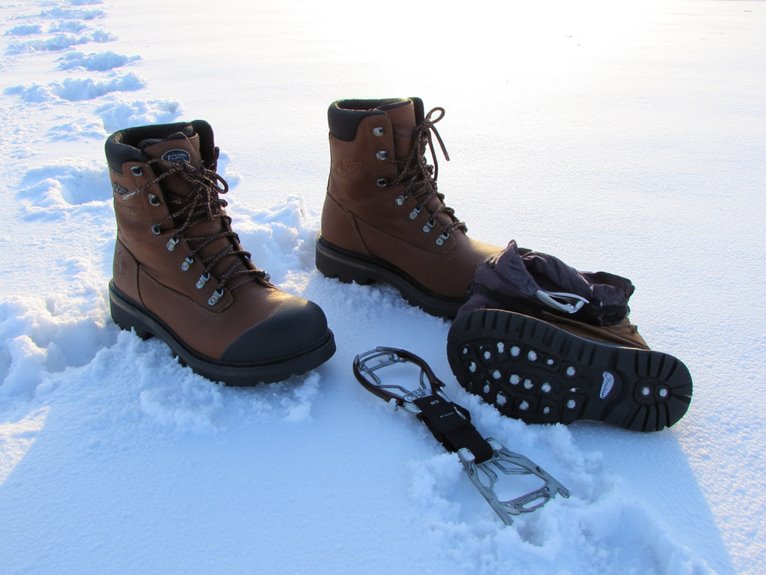How to Choose Footwear for Snow and Ice Backpacking
You’ll need waterproof boots with Gore-Tex membranes and aggressive traction systems for snow and ice backpacking. Choose spikes for steep icy terrain or microspikes for moderate conditions. Select insulation like Thinsulate or PrimaLoft based on temperature requirements and activity level. Confirm proper fit with half-inch toe space and accommodate thick hiking socks. Add gaiters to prevent snow entry and consider double-layer sock systems for enhanced warmth. The complete gear selection process involves several critical technical considerations.
We are supported by our audience. When you purchase through links on our site, we may earn an affiliate commission, at no extra cost for you. Learn more. Last update on 18th December 2025 / Images from Amazon Product Advertising API.
Notable Insights
- Choose waterproof boots with Gore-Tex membranes to prevent frostbite and hypothermia from moisture exposure.
- Select appropriate traction systems: spikes for steep ice, microspikes for packed snow, coil cleats for moderate conditions.
- Match insulation type to activity level: Thinsulate for active movement, PrimaLoft for warmth-to-weight ratio, sheepskin for moisture management.
- Ensure proper fit with half-inch toe space and try boots when feet are swollen wearing intended hiking socks.
- Use essential accessories like gaiters and merino wool socks while avoiding over-layering that restricts circulation.
Waterproofing and Moisture Protection
When you’re selecting footwear for snow and ice backpacking, waterproofing becomes your primary defense against frostbite and hypothermia.
Look for boots with Gore-Tex or similar waterproof membranes that block external moisture while allowing internal vapor transfer. These membranes don’t require additional waterproofing treatments on membrane areas—only regular cleaning maintains their effectiveness.
For leather components, moisture management depends on proper material-specific treatments. Full-grain leather requires different waterproofing treatments than nubuck or synthetic materials.
Factory-applied DWR finishes degrade over time, necessitating retreatment with silicone sprays or lanolin-based creams. Apply treatments to clean, dry boots for maximum penetration.
Monitor water beading on surfaces—when water stops beading, reapplication is needed.
Avoid wax-based treatments if future resoling is planned, as they interfere with adhesive bonding during repair processes. Additionally, clean fabric areas of boots with water only and avoid applying treatments to those sections.
Quality membranes effectively repel moisture initially, but their waterproof protection may degrade over time, affecting overall performance against wet conditions.
Many backpacking boots feature seam-sealed construction that prevents water penetration at vulnerable stitch points and enhances overall waterproof integrity.
Keep boots completely dry before heading out on a hike to ensure optimal waterproof performance in cold conditions.
Traction Systems and Sole Performance
While waterproofing keeps your feet dry, traction systems determine whether you’ll maintain secure footing or find yourself sliding down an icy slope. Understanding traction device types helps you match equipment to terrain demands.
| Device Type | Best Terrain | Weight | Durability |
|---|---|---|---|
| Spikes | Steep icy trails (15%+ grade) | Heavy | High |
| Microspikes | Packed snow, thin ice | Light | Medium |
| Coil Cleats | Moderate conditions | Lightest | Lower |
Traction performance differences become critical on technical terrain. Spikes excel on hard ice with superior penetration but accumulate snow buildup. Microspikes balance portability with effective grip on moderate surfaces. Coil-based systems provide 360-degree traction but offer less bite into hard ice. High-strength stainless steel maintains performance to -40°F, while rubber harnesses function reliably to -22°F before stiffening affects fit. Consider footwear with self-cleaning outsoles that feature deep lugs to prevent snow and ice accumulation between the sole and traction device. For optimal traction in winter conditions, look for outsoles with 3-7mm lug depth that provide superior grip on various terrains without compromising stability.
Insulation Requirements for Different Temperatures
Different insulation types serve specific needs.
Thinsulate offers lightweight breathability for moving activities.
Synthetic materials like PrimaLoft maximize warmth-to-weight ratios.
Natural sheepskin linings work best for high-activity scenarios where moisture management matters most.
For less demanding snow activities, memory foam construction in outdoor slippers provides excellent insulation while maintaining comfort during stationary periods.
Proper Fit and Comfort Features
Once you’ve selected boots with appropriate insulation, achieving proper fit becomes the foundation for comfort and safety during snow and ice backpacking. Your boots must accommodate your unique foot shape while providing adequate space for movement.
Allow approximately half an inch between your longest toe and the boot’s end to prevent painful impacts during descents.
Fit boots at day’s end when your feet are naturally swollen. Wear the thick synthetic socks you’ll use hiking, and bring orthotics if you use them. The arch should feel snug without pressure points, while the toe box needs room for natural toe spreading.
Even perfectly fitted boots require break in time. Wear new boots on short walks before extended trips to soften materials and conform to your feet, preventing blisters and discomfort on challenging terrain.
Look for boots with memory foam insoles or quality arch support to enhance comfort during long days of winter backpacking. A generous toe box is particularly beneficial for accommodating thicker winter socks without compromising circulation or comfort.
Essential Accessories and Layering Strategies
Beyond proper boot selection and fit, your footwear system’s performance depends heavily on the accessories and layering strategies you employ.
Gaiter selection prevents snow entry while maintaining breathability. Choose knee-high models for deep powder conditions.
Your sock materials form the foundation of thermal regulation. Merino wool provides natural odor resistance and moisture-wicking properties. Synthetic fibers offer durability and quick-drying capabilities. Use double-layer systems: thin liner socks reduce friction while thicker outer socks provide insulation.
Avoid over-layering, which restricts circulation and increases cold injury risk. Removable boot liners allow overnight drying and temperature adjustment.
Traction devices like microspikes enhance safety on ice. Waterproof socks add moisture protection in wet conditions. Chemical foot warmers provide supplemental heat during extended cold exposure. Boots with deep lugs of 5-7mm improve grip in snow and slush while maintaining flexibility in cold temperatures.
Consider cushioning levels based on your terrain difficulty, with light cushioning for moderate conditions and heavy cushioning for the most challenging winter backpacking routes.
Frequently Asked Questions
How Much Should I Expect to Spend on Quality Snow Backpacking Boots?
You should expect to spend $200-$300 for quality snow backpacking boots. Budget considerations include balancing cost with essential boot features like insulation, waterproofing, and durability needed for your specific winter hiking conditions.
What’s the Typical Lifespan of Winter Boots With Heavy Use?
You’ll get 1-2 seasons from heavily-used winter boots, roughly 800-1,920 km. Boot insulation and sole traction degrade faster with intense backpacking. Quality materials and proper maintenance can extend lifespan considerably.
Should I Break in New Winter Boots Differently Than Regular Hiking Boots?
Yes, you’ll need longer, gentler break-in sessions for winter boots. Their stiffer insulation types and waterproof membranes require gradual indoor wear first, then short outdoor walks to guarantee proper boot fitting without damaging materials.
On a final note
You’ve learned the critical factors for selecting winter backpacking footwear. Proper waterproofing prevents moisture infiltration. Quality traction systems deliver grip on varied terrain. Adequate insulation matches temperature requirements. Correct fit guarantees comfort and prevents injury. Don’t forget essential accessories like gaiters and microspikes. Your gear choices directly impact safety and performance. Test your complete system before heading into challenging conditions. Make informed decisions based on your specific route and weather forecasts.

